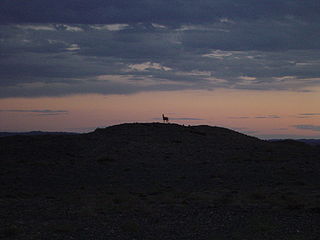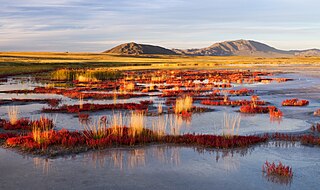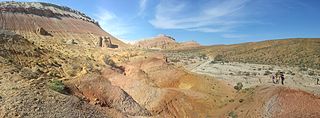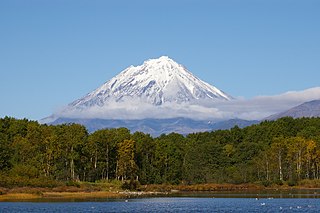
Mongolia is a landlocked country in East Asia, located between China and Russia. The terrain is one of mountains and rolling plateaus, with a high degree of relief. The total land area of Mongolia is 1,564,116 square kilometres. Overall, the land slopes from the high Altai Mountains of the west and the north to plains and depressions in the east and the south. The Khüiten Peak in extreme western Mongolia on the Chinese border is the highest point. The lowest point is at 560 m (1,840 ft), is the Hoh Nuur or lake Huh. The country has an average elevation of 1,580 m (5,180 ft).

The Eastern Gobi desert steppe is a deserts and xeric shrublands ecoregion in Mongolia and northern China. It is the easternmost of the ecoregions that make up the larger Gobi Desert. It lies between the more humid Mongolian–Manchurian grassland on the north, east, and southeast, and the drier Alashan Plateau semi-desert to the west.

The Ordos Desert is a desert/steppe region in Northwest China, administered under the prefecture of Ordos City in the Inner Mongolian Autonomous Region. It extends over an area of approximately 90,650 km2 (35,000 sq mi), and comprises two sub-deserts: China's 7th-largest desert, the Kubuqi Desert, in the north; and China's 8th-largest desert, the Mu Us Desert, in the south. Wedged between the arable Hetao region to the north and the Loess Plateau to the south, the soil of the Ordos Desert is mostly a mixture of dry clay and sand, and as a result is poorly suited for agriculture.

Zavkhan, also spelt Zaukhan or Zabhkhan, is one of the 21 aimags (provinces) of Mongolia, located in the west of the country, 1,104 km from Ulaanbaatar. Its capital is Uliastai. The aimag is named after the Zavkhan River, which forms the border between Zavkhan and Gobi-Altai aimag.

The Mongolian-Manchurian grassland, also known as the Mongolian-Manchurian steppe or Gobi-Manchurian steppe, in the temperate grassland biome, is an ecoregion in East Asia covering parts of Mongolia, the Chinese Autonomous region of Inner Mongolia, and Northeast China.

The wildlife of Jordan includes its flora and fauna and their natural habitats. Although much of the country is desert, it has several geographic regions, each with a diversity of plants and animals adapted to their own particular habitats. Fossil finds show that in Palaeolithic times, the region had Syrian brown bears, Asiatic lions, zebras, Asian elephants, and rhinoceroses, but these species are all now extinct in this region.

The wildlife of Niger is composed of its flora and fauna. The protected areas in the country total about 8.5 million hectares, which is 6.6 percent of the land area of the country, a figure which is expected to eventually reach the 11‑percent target fixed by the IUCN with the addition of more areas under the reserve category. Conservation of wildlife is ensured by laws and regulations enacted by the government of Niger, which has enforced a permanent ban on hunting so that animals such as lions, hippos and giraffes are safe in the wild.

Uvs Lake Basin is an endorheic basin located on the territorial border of Mongolia and Tuva, a republic of the Russian Federation. The basin is part of the Central Asian Internal Drainage Basin and is named after Uvs Lake, a large saline lake situated in the western part of its drainage basin, and is one of the last remnants of the mammoth steppes. Uvs Lake is a shallow lake with an area of 3,350 km2 (1,290 sq mi). Its entire basin, which includes several smaller lakes, is 70,000 km2 (27,000 sq mi).

The Gobi Desert is a large, cold desert and grassland region located in northern China and southern Mongolia. It is the sixth largest desert in the world. The name of the desert comes from the Mongolian word Gobi, used to refer to all of the waterless regions in the Mongolian Plateau; in Chinese, Gobi is used to refer to rocky, semi-deserts such as the Gobi itself rather than sandy deserts.

The Central Asian northern desert is an ecoregion in the deserts and xeric shrublands biome, located in the Central Asian countries of Kazakhstan and Uzbekistan. The annual precipitation ranges from 100 to 150 mm, the winters are cold at −10 to −15 °C and the summers hot at around 25 °C (77 °F). There are a range of habitat types including salt flats, clay desert, rocky desert and some sand desert. The vegetation consists of scanty xeric shrubs including Artemisia and Salsola. The fauna is varied, as well as mammals and birds, there are a large number of reptiles and many species of invertebrate. Some protected areas are included in this ecoregion but other parts are being degraded by conversion to farmland, overgrazing and poaching.

The wildlife of Russia inhabits terrain that extends across 12 time zones and from the tundra region in the far north to the Caucasus Mountains and prairies in the south, including temperate forests which cover 70% of the country. Russia's forests comprise 22% of the forest in the world as well as 33% of all temperate forest.
Great Gobi B Strictly Protected Area is a nature reserve in Gobi Desert, situated in the southwestern part of Mongolia at the border with China. A similar reserve in a drier part of the Gobi exists further to the east - the Great Gobi A Strictly Protected Area.
The Southern Siberian rainforest is an area of temperate rainforest in South Central Siberia that occurs primarily along the Altai and Sayan mountain ranges in Khakassia and Tuva as well as a small area in the Khamar-Daban Mountains near Lake Baikal in Buryatia. The forest encompasses a total area of approximately 6,000 square kilometres (2,300 sq mi). The larger portion of the forest in the Altai and Sayan Mountains runs across a latitude range that encompasses between 51.5 degrees to 56 degrees north latitude, and a longitude range running between 86 degrees to 95 degrees east longitude. The region overlaps with the Golden Mountains of Altai World Heritage Site. Ecological zones range from hemiboreal forest to a forest-steppe ecotone and include a wider variety of plant species than surrounding areas.
The Great Gobi A Strictly Protected Area is a nature reserve in the Gobi Desert, situated in the southwestern part of Mongolia at the border with China. A similar reserve in the Gobi exists farther to the west - the Great Gobi B Strictly Protected Area. Both reserves form one unit, the Great Gobi Strictly Protected Area (SPA), which encompasses a total of 53,000 km2 (20,000 sq mi). Great Gobi A is one of the last refuges for critically endangered animals such as the wild Bactrian camel and the Gobi bear.
The Ikh Nartiin Chuluu Nature Reserve, commonly shortened to Ikh Nart Nature Reserve is a protected area in Dornogovi Province, Mongolia. It occupies part of two counties, Dalanjargalan and Airag. The nature reserve has an area of about 66,000 hectares and was established in 1996. It consists of rocky outcrops surrounded by dry grassland and semi-desert steppe and is one of the places in which the rare argali wild sheep can be found.

Katon-Karagay National Park is the largest national park in Kazakhstan, located on the eastern edge of the country, in the Southern Altai Mountains. The park fills the west side of the "X" where the borders of Kazakhstan, Russia, China, and Mongolia meet. The highest peak in Siberia, is on the Russian border in the Katun Range. The park is in Katonkaragay District of East Kazakhstan Region, 1,000 kilometres (620 mi) southeast of the capital city of Astana.

The Altai montane forest and forest steppe ecoregion covers patches of the subalpine forest belt on the Altai Mountains, crossing the border region where Russia, Kazakhstan, Mongolia and China meet. The region has high biodiversity, as it is located in transition zones between different ecoregions, altitudes, and climate zones. It is in the Palearctic realm, with a Cold semi-arid climate. It covers 35,199,998 km2 (13,590,795 sq mi).

The Gobi Lakes Valley desert steppe ecoregion covers the narrow, flat valley in southwestern Mongolia that lies between the Khangai Mountains, and the Gobi-Altai Mountains. The region is known as the "Valley of the Lakes" because runoff from the mountains collect in lakes that have no outlet to the sea. Although the valley is a semi-arid desert steppe, it has areas of wetlands near the lakes that are important habit for water birds.

Ikh Bogd Uul National Park is centered on Ikh Bogd, the highest mountain in the Altai-Gobi Mountains, a southeastern spur range of the Altai. The middle and high elevations feature alpine meadows and montane steppe. The range, with semi-arid deserts to the north and south, supports rare species, such as the near-threatened argali and Pallas's cat.




























